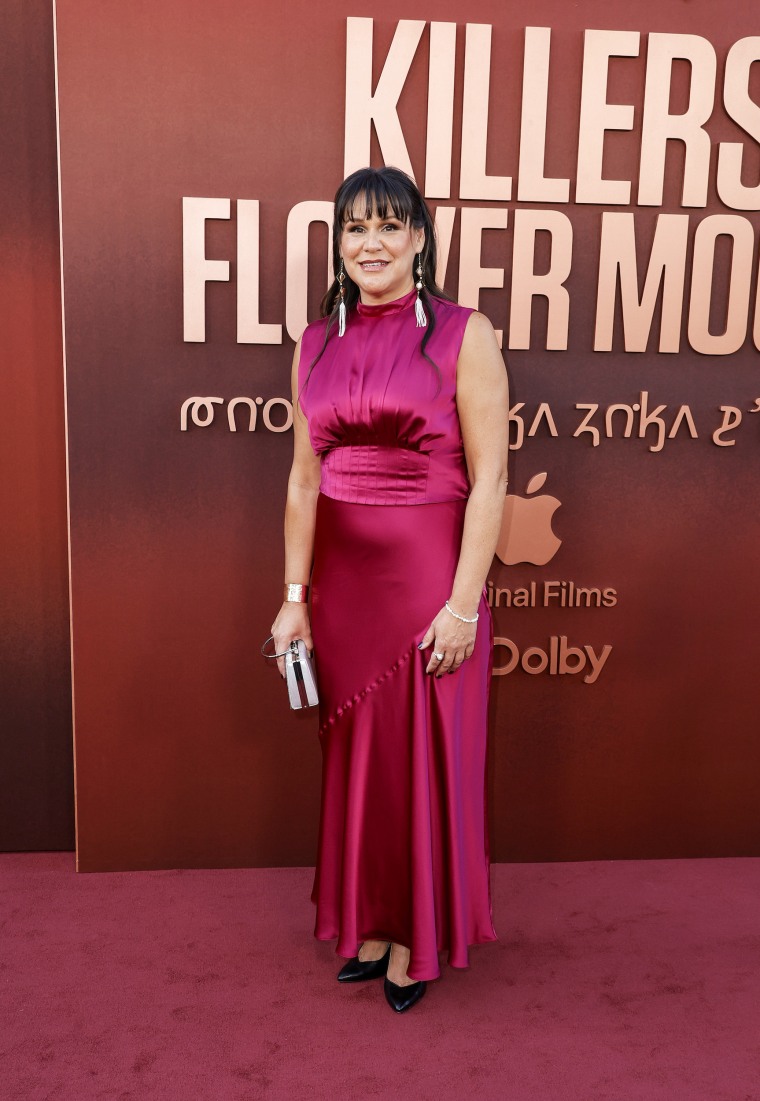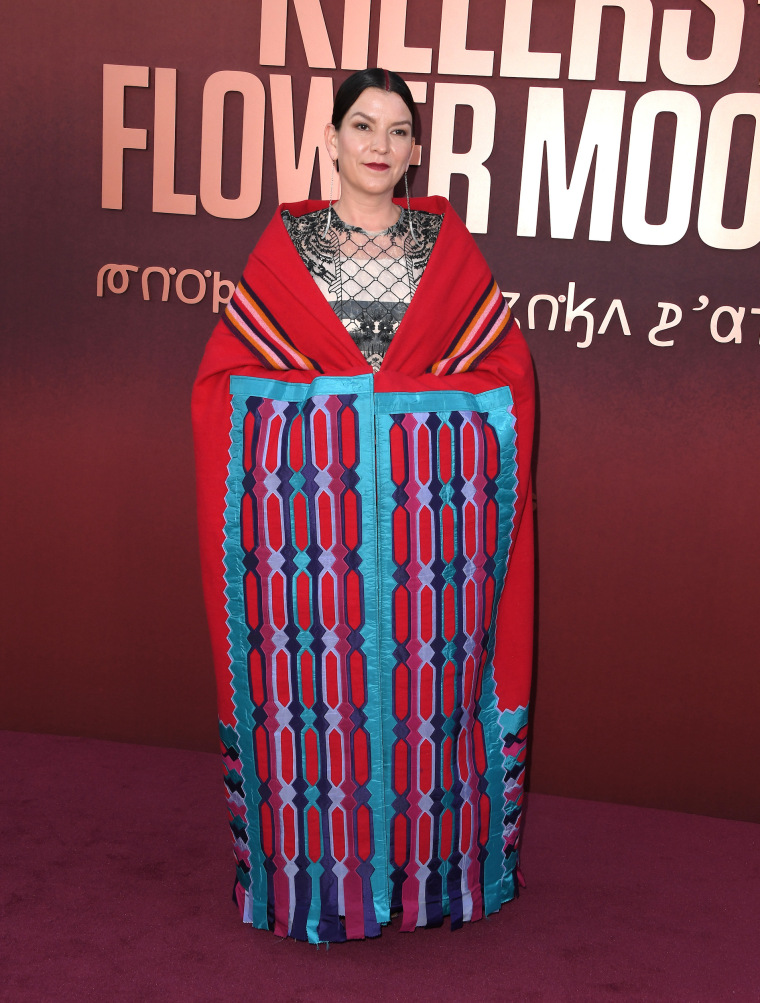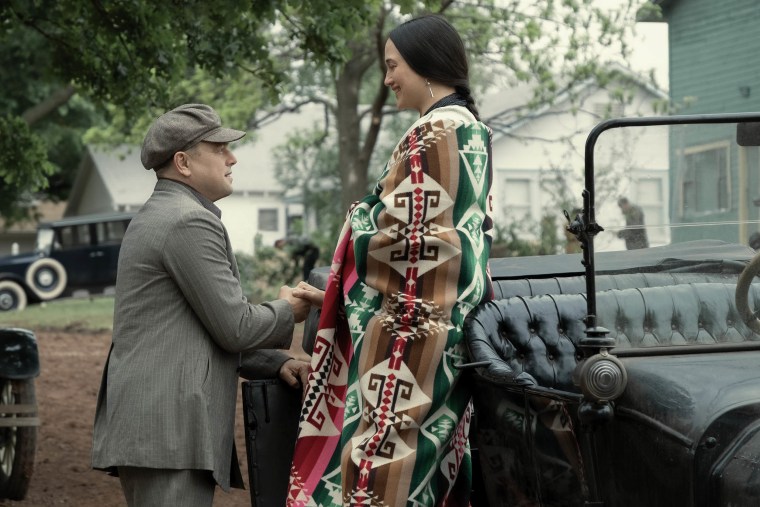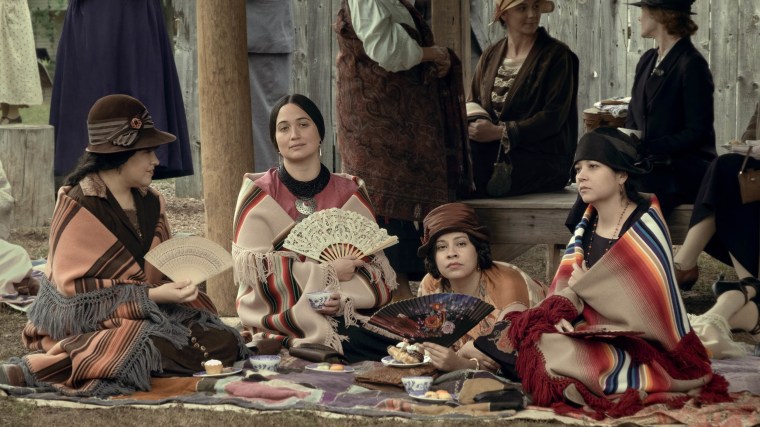“Killers of the Flower Moon” shines a spotlight on a bloody moment in American history, when over dozens of members of the Osage tribe met violent or suspicious ends following the discovery of oil on their Oklahoma land.
While some audience members may be unfamiliar with the Osage murders, members of the Osage Nation and descendants of the movie’s characters know the story all too well.
Directed by Martin Scorsese, the movie stars Leonardo DiCaprio as Ernest Burkhart, a World War I vet who moves to Fairfax, Oklahoma, to work for his uncle, William Hale (Robert De Niro).
He marries Mollie (Lily Gladstone, who is of Blackfeet and NiMíiPuu heritage per production notes), a wealthy member of the Osage Indian Nation. Soon after, members of her family die in horrific ways, and a story of greed, racism and complacency unfolds, written in David Grann’s 2017 book of the same name.
According to production notes, the team behind the film worked closely with the Osage community, meeting with prominent members ahead of filming. Chief Standing Bear, at a land blessing ceremony, at the start of filming said, “The respect that Mr. Scorsese and his team have displayed toward us is more than we hoped for. Such sensitivity is welcome and is a continuation of the respect David Grann showed us.” More than 44 roles were filled by Osage actors, and the film employed Osage artisans for behind-the-scenes work.
Now that the film is opening in theaters Oct. 20, what do members of the Osage Nation think? At the Los Angeles red carpet, TODAY.com spoke to Osage Nation members to find out.
Attention to details: ‘They listened’
Osage Nation Congress member Brandy Lemon, who served as the liaison between the Osage community and the production, said she was surprised to receive a call about working with the movie production.
“I didn’t know what that meant. I’ve never worked in the movies before. I’m a nurse by training. So I had a lot of questions,” she said.

Lemon weighed the opportunity. “This is something that’s bigger than any of us. I didn’t want to disappoint my people. My mom, my family, our community. We sat, talked and prayed and thought about it for a long time. My mom said, ‘Go for it,’ so I went,” she said.
Once on set, Lemon provided insight into details big and small. For example, when Ernest and Mollie were having dinner, Lemon corrected how Gladstone was holding her cup. “Small things like that — that’s how involved they were, and willing to immerse themselves in little things and big things we saw. They would take that in and absorb that,” she said.
Lemon was appreciative of the filmmakers' approach. “They listened, that was the biggest thing,” Lemon said. “They actually listened to us. We weren't considered what people say 'token Indians.' They saw us as people.”
How the Reign of Terror lives on
Addie Roanhorse joined the film’s production as an assistant art director. She is the great-great granddaughter of Henry Roan, who was killed during the Osage murders, and was depicted in the film by William Belleau.
Roanhorse said the movie's impact on the Osage community has been hard to take in and process, especially once they see the violent events depicted.

“It’s heavy. It’s like somebody hands you something heavy and walks off. Everybody’s standing there going, ‘What is this? What do we do with this?’” Roanhorse told TODAY.com on the red carpet.
Roanhorse said she and her family have always been deeply connected to the story, but that it wasn’t widely known.
“I also knew that we would tell the story to people and they wouldn’t believe us,” Roanhorse said. “It took a Martin Scorsese to come along, that sort of powerhouse, to tell the story properly, and how he approached the community and how he worked with all of us, we just felt included.”
She hopes the film will inspire the younger Osage generations to tell their history — this chapter included.
“My grandparents didn’t talk about it. They feared retaliation. I want my daughter’s generation to speak, tell our stories and be proud of who we are.”
Gianna Sieke, who was an Osage Nation princess from 2021 to 2023 and was present during production, first saw the film at a screening in Tulsa, Oklahoma, with other Osage members, and agrees that the movie starts a conversation.

“It does tell our dark history but it’s also including things that no one really knows, and it hasn’t been expressed to Osage people and anyone because it’s a dark history,” Sieke told TODAY.com. “People don’t really talk about it that much. And because of that, (the movie) has made a really big impact. Families are learning to cope and understand.”
Lemon said she anticipated the movie being difficult to watch — and it was. She was on set for the moment Mollie learns of a tragedy.
“Even though I knew that happened and that scene was coming, I still wasn’t ready for it. It just hit me in the gut so hard and every time I watch it, it still does,” Lemon said.
Whose story is it? A debate rages
While the movie is about the Osage murders, the lens is kept tightly on Ernest and Mollie. Previous iterations of the script were on the FBI and the Texas Rangers, before filmmakers decided to expand on this story cited in Grann’s book, per production notes.
“Ernest and Mollie were the key,” Scorsese said in production notes. “It’s all based on trust and love, and we see that being compromised and betrayed. And what’s the motivating factor? Always wanting more: more land, more money.”

Sieke said the movie raised questions about the real Mollie Burkhart’s level of awareness.
“I’ve had this conversation with my family. Does she know that this was going to happen to her? Did she anticipate it? That’s a thing my people still have today. We’re hard with trusting issues. It’s not trust issues, it’s generational trauma," she said.
Ernest is arguably the movie’s main character, as his role in the nefarious plot becomes clearer and clearer. Members of the Osage Nation had mixed responses to the story’s point of view.
Christopher Cote, who worked on the film as an Osage language consultant, had “strong opinions” about the movie’s focus on Ernest, which he shared in a red carpet interview with The Hollywood Reporter.
“As an Osage, I really wanted this to be from the perspective of Mollie and what her family experienced, but I think it would take an Osage to do that,” Cote said. “Martin Scorsese, not being Osage, I think he did a great job representing our people.
“This history is being told almost from the perspective of Ernest Burkhart and they kind of give him this conscience and kind of depict that there’s love," he said. "But when somebody conspires to murder your entire family, that’s not love. That’s not love, that’s just beyond abuse.”
Sieke said while the film was not made by a member of the Osage, the future of Osage people in positions where they can tell their stories to a wider audience seems brighter.
“As Native Americans and as Osage, we are storytellers. We are meant to be storytellers,” Sieke said. “And I feel like it’s very important for us to continue telling our history and what’s going on in our communities.”

